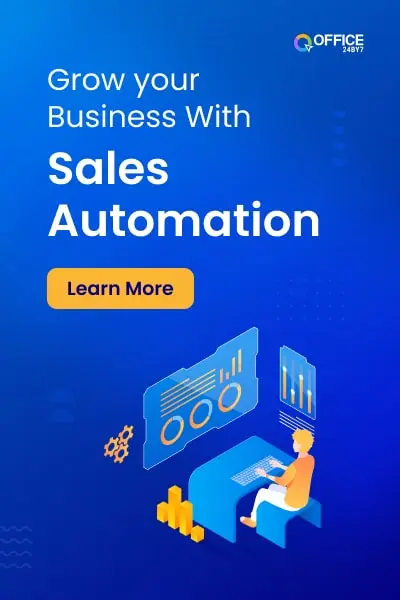Every marketing expert shares a common goal: to attract more clients and boost the organization’s revenue. The challenge lies in how to best achieve this goal for your brand. Typically, businesses start by leveraging their existing connections. However, when those options are exhausted, lead generation becomes the next logical step. A marketer’s primary task is to assess the actual value of leads, as not all leads may initially appear equally valuable upon closer inspection. Through lead tracking, marketers can harness data to prioritize their time and resources on the most valuable leads.
In today’s digital landscape, value creation, data, and analytics are subject to specific constraints and demands. Therefore, every data-driven business endeavors to gain a deeper understanding of what motivates buyers, generates leads, and ensures customer satisfaction. Now, let’s delve into the specifics of lead tracking and the supplementary tools that can enhance this process, helping you fine-tune your lead funnel.
What is Lead Tracking?
So, what exactly is lead tracking, and why is it so crucial? It’s common knowledge that, in the current landscape, more information and automation software tools are indispensable. Lead tracking is the most effective way to capitalize on revenue opportunities and manage the lead lifecycle. It allows you to categorize customers and monitor their interactions across all touchpoints. Utilizing data to guide product and service development results in more relevant consumer interactions, ultimately increasing customer loyalty and revenue. Nevertheless, many marketers still grapple with the challenge of acquiring, consolidating, and effectively utilizing data throughout the various stages of the lead journey.
It’s no secret that acquiring the necessary data sets poses a significant hurdle for organizations. Research indicates that four out of five sales representatives acknowledge major discrepancies in the information used by sales and marketing. This is where tracking software becomes a valuable asset for lead generation campaigns. For example, its data-discovery capabilities can help bridge the gap between the sales and marketing departments.
Office24by7, a marketing automation software platform, empowers businesses to aggregate all the essential marketing data in one centralized location. This enables them to confront any marketing challenge with confidence. With an efficient lead monitoring tool, marketing and sales professionals can track the sources of leads and determine their inbound/outbound status.
For those just entering the field, here’s a breakdown of both approaches. Lead tracking plays a pivotal role in aligning marketing and sales efforts and ensuring that valuable leads are properly nurtured and converted into loyal customers.
Distinctions Between Inbound and Outbound Marketing

What is Outbound Marketing?
Outbound marketing tool is the more common and established method, and it includes the likes of billboards, radio advertisements, telemarketing, direct mail, and television commercials. Banner and display adverts, pop-ups and pop-unders, and cold email marketing are all examples of this kind of advertising on the web.
Simply said, outbound marketing encompasses any promotional activities not solicited by the target audience. This is why “push marketing” is another name for this strategy.
Recent years have seen a decline in the popularity of outbound marketing strategies. Banner blindness and the proliferation of ad blockers are only two effects of advertising overload, which is particularly an issue in the digital realm.
However, outbound strategies will continue to exist. Instead, they use cutting-edge, interactive methods to communicate their message to customers. The global market for out-of-home (OOH) advertising, which includes billboards, is projected to climb to more than $42 billion by 2024. Forecasts place the total value of display ads served at over $500 billion by 2026, up from almost $340 billion in 2022.
What is Inbound marketing?
Instead of forcing advertisements and information onto consumers, inbound marketing aims to arouse interest and encourage interaction to bring customers to you. This kind of advertising is called “pull” since consumers actively seek it out. Inbound marketing’s primary strategy is content promotion, which gives rise to the term’s alias.
To attract and retain customers, inbound marketers use a wide range of content formats. Articles on blogs and social media, infographics, white papers, email newsletters, e-guides, quizzes, surveys, and more all fall under this category. Marketers may also use paid search and native advertising as inbound marketing strategies to get their target audiences to discover and interact with their content.
The goal of inbound marketing software is to progressively raise brand recognition, increase customer engagement, and draw prospective consumers towards conversion and retention by exposing them to relevant information and brand experiences at the appropriate time and place throughout the marketing funnel.
When comparing inbound and outbound marketing, what are the key differences?
Using paid advertisements, email lists, and other methods to spread your brand’s name and encourage others to purchase is an example of outbound marketing.
As opposed to outbound marketing, inbound marketing aims to increase conversions by attracting and retaining customers with high-quality content that is tailored to their needs.
Inbound marketing draws clients to you since you’re targeting audiences that are interested in, or actively seeking, your services or goods, as opposed to broadcast advertising to a vast audience that may not be interested in your product or responsive to your messaging.
Another key distinction between inbound and outbound marketing is the former’s emphasis on the Internet and the latter’s usage of both offline and online channels.
Inbound leads are prospective customers who seek out your company on their own, either via an online search, a personal recommendation, or by accident when they come across your material. They tend to be more reliable and eager to spend more money because of the rapport you’ve built with them.
Since you have to be the one to make first contact with an outbound lead, it is called a “cold” lead. The outbound procedure might be inefficient due to its invasive nature.
The implementation of an inbound marketing plan is often more time-consuming and resource-intensive. Perhaps you’ve found that it’s more challenging to quantify the results of your inbound marketing efforts.
However, with the correct lead tracking technology, organizations can get thorough attribution, seal off weak spots in their sales funnels, apply pinpoint marketing, and dispense with inefficient methods.
Importance of Information in Lead Generation

Insights derived from data are now essential to the development of every brand. It doesn’t matter whether you’re doing content marketing, email campaigns, or product trials. The end aim is the same: to attract more high-quality leads.
Businesses may increase their profits with the use of data and imagination.
A company’s marketing department’s top priorities might change over time as it adapts to factors, including shifting brand priorities and the need to upgrade its resources and methods.
Given the increased cadences and marketing requirements, the necessity to leverage the power of data is apparent.
Businesses nowadays have processes to produce and disseminate plenty of material, track how well it does, and generate more leads.
Consider customization as an example. The focus has shifted away from UX alone. The primary focus of modern marketing is on maximizing the value of data from each customer touchpoint to create highly targeted messages.
According to a recent survey from HubSpot, 40% of marketers believe it is critical to focus on increasing inbound leads throughout the year. This, in turn, necessitates having ready access to comprehensive reports on the leads produced.
Ultimately, the tracking software deployment offers organizations the key to an improved consumer base, better sales volumes, and precisely calculated return on investment (ROI).
How is Tracking Procedure Carried Out?
What solutions can you provide to meet the requirements of potential customers? You must first collect and organize information on your leads. Finally, salespeople must prioritize and qualify the leads. It may be quite expensive to cope with incomplete information.
Lead monitoring provides your company with the tools to monitor inbound calls and online inquiries (if any). This will allow you to organize your lead qualifying process and focus on closing deals.
I know what you’re thinking: it’s easier said than done. But don’t worry; anybody may use the tracking software without specialized knowledge or training.
All you have to do is choose a system that is intuitive and simple to set up. This detailed article will teach you all you need to know about keeping tabs.
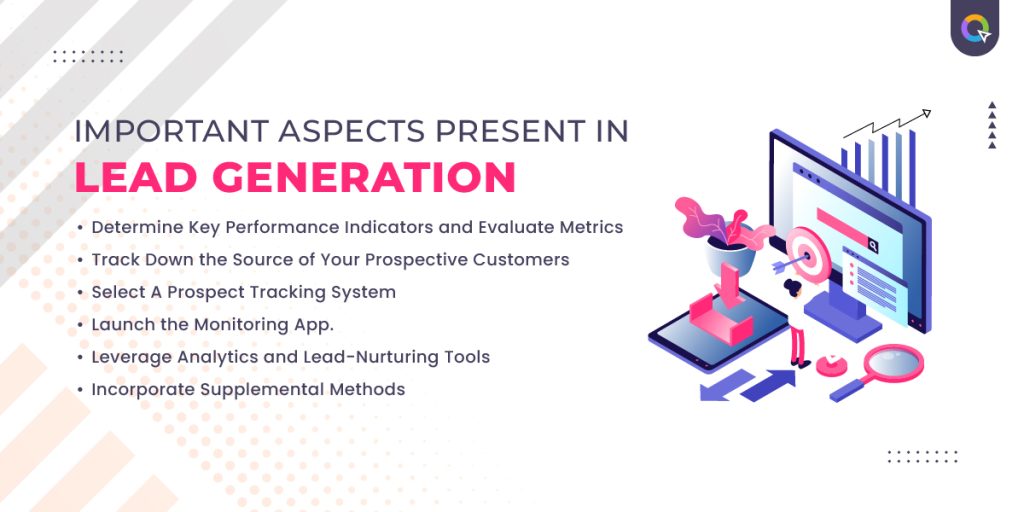
- Determine Key Performance Indicators and Evaluate Metrics
- Track Down the Source of Your Prospective Customers
- Select A Prospect Tracking System
- Launch the Monitoring App.
- Leverage Analytics and Lead-Nurturing Tools
- Incorporate Supplemental Methods
1. Determine Key Performance Indicators and Evaluate Metrics
First, let’s establish some terminology.
Metrics are quantifiable values that may be monitored over time. In this way, the efficacy of a chosen approach or method may be evaluated. Key performance indicators (KPIs) are indicators or conditions that show how far along the path to success an organization is.
One of the most important things for a company to do is to figure out how the metrics and key performance indicators related to lead generation affect the bottom line. A high lead count can seem like the be-all and end-all of a campaign’s success, but that’s not the case.
Let’s look at some lead-generating indicators that marketing gurus stress the most.
Marketers also pay close attention to the cost per acquisition and cost per lead, which are not included in the graph. Where do we draw the line? So, CPL measures the effort required to generate a single potential customer.
Cost-per-acquisition, however, is often used for later-funnel events. For example, of the 850 times your ad was clicked, 54 potential customers showed interest. However, only 8 became paying customers.
In this approach, brands control how much money they make. In this context, the most important thing is the money converted customers bring in. The time potential customers spend on your website is another crucial measure.
It provides valuable insight for marketers about the level of interest shown by leads in their material. It’s also an indicator of how likely they are to come back.
Marketers generally prioritize the traffic-to-lead ratio when analyzing online traffic. It can tell you whether problems are widespread throughout your material or just on a few landing pages.
The last metric is the success rate of closing. One of the most important indicators for salespeople it may also reveal gaps in the closing process. One reason is that salespeople don’t know enough about the product, and another is that they can’t meet customers where they are in the sales funnel.
By combining these measurements with brand-specific KPIs, you can better understand the lead-generation process and adapt your approach accordingly.
2. Track Down the Source of Your Prospective Customers
Understanding where your leads are coming from is essential, whether they came through a blog post, an organic search result, or a referral.
It’s common knowledge that marketers should prioritize contacts ready to buy. Using lead tracking software, businesses may keep tabs on their leads’ opening rates, webpage views, and form submissions to determine which marketing channels provide the most fruitful leads.
You may boost your brand’s analytical decision-making and acquire deeper insights into the phases leads go through while learning about your company using several tracking tools that are part of a single suite of marketing solutions.
Despite appearances, many business dealings are still conducted by phone and in person. This is why you should look for a comprehensive lead tracking solution.
By integrating the lead tracking tool and call monitoring into a single marketing suite, companies can see the full scope of customer interactions and touchpoints.
Who, if anybody, would turn down the chance to track every one of their customers, identify their referral sources, and eliminate the guesswork from their marketing attribution? True, no marketer would ever do that.
3. Select A Prospect Tracking System
It is naive to assume that simple spreadsheets or basic programs can handle your needs. What you need is efficient lead management and distribution.
Here are some things to think about before settling on a certain lead tracking system:
- In the present financial plan
- Onboarding time for new software
- Installation and startup time for the program
- Capabilities for integration
- Hosted or Self-Hosted Servers
- Provided Bundles
- Complementary Options
There will always be variation from one company to the next.
This implies that after thorough consideration, you may determine that some characteristics are enough to meet your requirements. It might be a customer relationship management (CRM) system or an email marketing platform targeted at managing the sales funnel.
But you must form a routine while keeping your ultimate goal in mind. The day will come when both your staff and company expand. Rather than wasting time seeking a solution that falls short, you should think about using automation technologies straight immediately.
Consider the tailor-made strategy before you freak out over the potential financial commitment. It’s possible that you don’t require every function right now. In a fortunate twist of fate, it is how individualized strategies function.
Assume you run or are employed by a small home service business (fewer than 30 people). You should not worry about the industry dying out; all you need to do is keep tabs on and drive leads. Home service appointments are often scheduled over the phone. As a result, it’s important for you to know the context of such conversations, whether you’re a service provider or a marketer.
You probably promote events and products online and offline but provide your services in person. Therefore, an accurate campaign attribution tool, interactive voice response (IVR), call routing, and lead tracking are essential.
You may want to prioritize providing seamless service, but even a tiny company may benefit greatly from a comprehensive marketing solution.
4. Launch the Monitoring App
First, you must test every system and piece of software. Once you’ve settled on a supplier, it’s time to set up a session with business professionals to discuss your specific requirements. So, you may learn about and compare different packages or talk about tailoring a solution to your needs.
Excuse me, but how about your team? You can guarantee a successful rollout by following these steps:
- Pick a deal from the many bundles and special packages we offer.
- Examine how adding a solution bundle or a single cutting-edge function might improve the output of your business’s sales and marketing departments.
- Consult a service provider for help in setting up your software.
- When necessary, hold training sessions.
- Force people to utilize the software.
5. Leverage Analytics and Lead-Nurturing Tools
In this day and age, we all know that tracking is a vital part of any lead management system in India. That’s why it shouldn’t be surprising that analytics and the lead nurturing process are intertwined.
Exactly what is meant by “nurturing leads”?
Relationship marketing entails maintaining interest in your brand among potential customers. Exactly why is it necessary on your part?
You have around fifty percent unqualified leads in your system. The good news is that with the right lead nurturing strategies, you can transform them into marketing-ready prospects.
If you want to win their trust, keep their attention, and ultimately convince them to purchase, you’ll have to figure out what they want and provide it.
Several types of outreach strategies and materials may do this.
Let’s take a peek at the lead nurturing process’s primary goals.
- The need to boost conversion rates
- Improve the qualification of leads.
- Boost your chances of making a deal.
- Expand information about potential customers
- Increase brand awareness
- Internet site customization
- Utilization of several channels
Ultimately, lead nurturing is all about influencing customers’ choices by providing them with relevant marketing content at appropriate times during the purchasing process.
What do we want to accomplish with all this “lead analytics” stuff?
Analyzing data is essential for every company that wants to develop more successful advertising strategies and take advantage of actionable insights.
Comparing data sets, seeing patterns and gaps, drawing on real-time reports of traffic flows, and stumbling upon untapped development possibilities are all made possible by lead analytics.
Lead analytics may provide a wealth of information that can be used to improve marketing tactics and target audiences. You may streamline processes and adjust your marketing approach with the help of the correct lead system.
6. Incorporate Supplemental Methods
As a result, many companies are searching for marketing platforms that provide more options and resources for their businesses. The motivation for the hunt may be different for everyone.
The majority of companies, however, are prepared to invest in a marketing automation package that will aid them in a wide range of areas, including sales process simplification, call monitoring, sales funnel optimization, lead qualifying, and data consolidation.
Consider incoming phone calls as an example.
These days, many firms still rely heavily on offline methods of generating leads and revenue. However, many argue that phone calls are no longer necessary in this day and age. Therefore, the efficacy of phone conversations is either dismissed or undervalued.
Call monitoring software, in practice, may assist marketers in filling in the data gap between their offline and online operations.
Your offline and online marketing efforts will not succeed without in-depth reports and information, even if your sales force isn’t making money from incoming calls. Consequently, call monitoring is still widely employed as a supplemental strategy for generating leads.
Another excellent example of a supplementary feature is predictive modeling. The goal of this valuable resource is to assist companies in improving their lead-scoring models by revealing hidden resources and conversion possibilities in their sales processes.
The only way for marketers to find new growth opportunities and attract the attention of every possible client is to mine data from prior encounters with consumers and make predictions based on that information.
Where may a small company get the most benefit from lead tracking software?
One of the most important ways in which organizations may increase their income and monitor their return on investment is via the use of a sales lead tracking and management tool.
In addition, businesses may analyze the success of each marketing campaign and observe the customer’s progress thanks to lead tracking. Marketers may use this potent resource to fill in the gaps and examine finer points of lead information.
What kind of information can we obtain from calls using lead tracking software?
Usually no, call details aren’t a part of lead tracking software. Companies using call data should implement a call monitoring and analytics system.
Some cloud-based service providers package other resources, such as predictive modeling, with their call monitoring and sales lead management software. For businesses that operate call centers, special deals like these might be quite useful.
Effective Lead Management: The Key to Closing More Sales
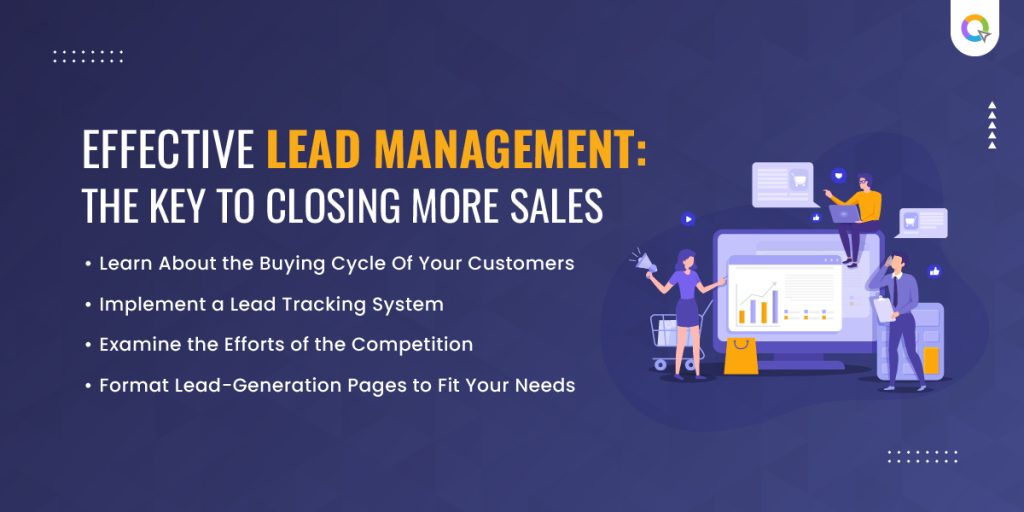
You may effectively watch your sales pipeline and maintain orderly data regardless of using a customer relationship management system or a lead monitoring spreadsheet.
The marketing and sales departments, in particular, will benefit from a streamlined method of internal communication.
How to monitor sales leads in only 5 easy steps?
1. Learn About the Buying Cycle Of Your Customers
What thoughts and feelings does the customer go through from realizing they have an issue until they purchase from you?
Success in sales greatly depends on taking the lead’s point of view throughout the purchase process. Knowing where a prospect is in the sales cycle can help you categorize them more precisely.
A customer who is still in the “awareness” stage of the buying process isn’t ready to talk about the product’s features with you. They have a tenuous grasp on the nature of the issue and the need to address it.
Equally, a lead ready to buy has little interest in learning more about your products or services. If they want your SDRs to make the call, they’ll need to talk with them.
2. Implement a Lead Tracking System
Improve your sales results with the help of lead tracking software.
You won’t need pen and paper to monitor each potential customer. You can’t effectively handle lead information or apply it to your sales process without a sophisticated tracking tool.
The easiest strategy to keep tabs on sales leads and boost performance in the sales process is to use software for lead monitoring. Using tracking technologies, for instance, you’ll have complete authority over lead profiles, allowing for more effective prospect data management.
Also, with the help of lead tracking software, you can figure out where your leads are coming from and what actions each potential customer is doing on your website. To further improve lead scoring, categorization, and engagement, you may send each lead more tailored messaging.
Knowing at all times where your leads are in the sales cycle. Increasing interactions and sales requires transparent visibility into prospect activities.
Lead scoring may be done automatically using lead tracking software based on information like corporate information, decision-making authority, interest level, and behavior. A trustworthy scoring model built on measurements and real-time data, rather than speculation, is what you’ll have.
This helps in determining whether leads are ready for a sales interaction. You’ll also be aware of which leads need further attention to get them closer to the decision stage of the sales funnel.
3. Examine the Efforts of the Competition
There are many missing pieces in the sales puzzle. There’s always something new to discover about methods, resources, and developments that may catapult your success.
As an example, when introducing a new product or service, you have a better opportunity to attract customers and encourage them to purchase. Analyzing the performance of your rivals is an easy technique to obtain insight into this area.
This is particularly helpful when launching a new strategy or seeking to boost profitability swiftly.
The reality is that you should adopt your rivals’ successful strategies. This means you won’t have to start from scratch or spend months gathering information about your ideal customers.
Instead, leads from companies that are comparable to yours may be simply analyzed, allowing you to get insight into how competitors are handling their leads. You may learn a lot that can enhance your sales process and increase interactions in this method.
4. Format Lead-Generation Pages to Fit Your Needs
If done properly, a lead generating form may provide extensive information on potential customers. Many data on your leads may be gathered without making them fill out many forms.
Generally speaking, you need to make it as simple as possible for your leads to fill out your online forms. You should only inquire for mandatory information, including a complete name, job title, firm name, and email address.
Without making visitors complete a visible form, you can find out where your leads are coming from.
Instead, you will implement a covert input field into your current forms for generating leads. The UTM code from the prospect’s referring link will be stored in this hidden field. From there, it may tell you exactly what ad or link they clicked on to get there.
Directly asking your leads where they heard about you is another reliable method of tracing the origin of your leads. Including a “choose” box in your form with the most common advertising methods is all that’s required.
Optimal Characteristics of a Lead Tracking Program
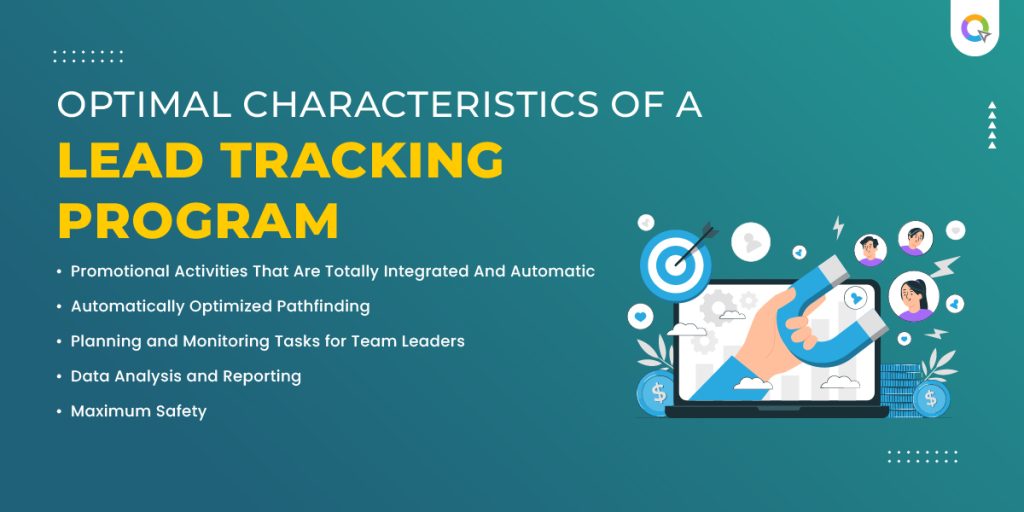
Promotional Activities That Are Integrated And Automatic
It is common knowledge that most businesses attract new customers via advertising. Many mobile apps and desktop programs for managing leads in the cloud enable you to dynamically merge client data gathered from various marketing channels (email, website, third-party portals, etc.).
This will allow you to monitor the efficacy of your methods and determine which ones produce the desired results. You may avoid making costly duplicate contact information submissions and cut down on ineffective marketing channels.
Automatically Optimized Pathfinding
Each business has its unique organizational structure. Some businesses assign responsibilities to salespeople under geographic territories, while others choose a more personalized approach based on each employee’s unique set of skills. Now, with the use of a lead management mobile app or software, you can instantaneously alert your sales staff of their assigned responsibilities and have them immediately assigned and routed to them. This ensures that everyone in your team works at a similar pace and on similar projects.
Planning and Monitoring Tasks for Team Leaders
Given that your sales crew is likely out in the field going about the organization’s business most of the time, it may be difficult to remember which leads they have pursued. This is where a piece of mobile software or app dedicated to lead management comes into play. Thanks to this fantastic program, your sales agents may now monitor their day-to-day tasks inside the mobile app itself. In addition, customers may set up meetings and follow-ups with their contacts, as well as get email reminders and alerts. You may rest easy knowing that you won’t ever pass up an opportunity because of this.
Data Analysis and Reporting
Business report generation is sometimes a tedious process, especially for big corporations. Consequently, a mobile app and software for managing leads in the cloud may reduce reporting burdens by a factor of two or more. Using lead management software, you can easily monitor and assess your company’s performance. Using this program, you may track anything from conversion rates to the return on your marketing dollars. CRM makes it simple to monitor lead generation and performance over time.
Maximum Safety
Information about your customers and the operations of your company is invaluable and must be protected at all costs. Report maintenance the old-fashioned way may cost a lot of time and money. If you decide to use a CRM system in India, you’ll be taking an important step toward increasing the safety of your company. Your data may be protected from the inside out as well as the outside in. Internal sales representatives, for instance, are restricted to seeing just the leads that pertain to their specific territory.
Three Typical Errors in Sales Lead Tracking
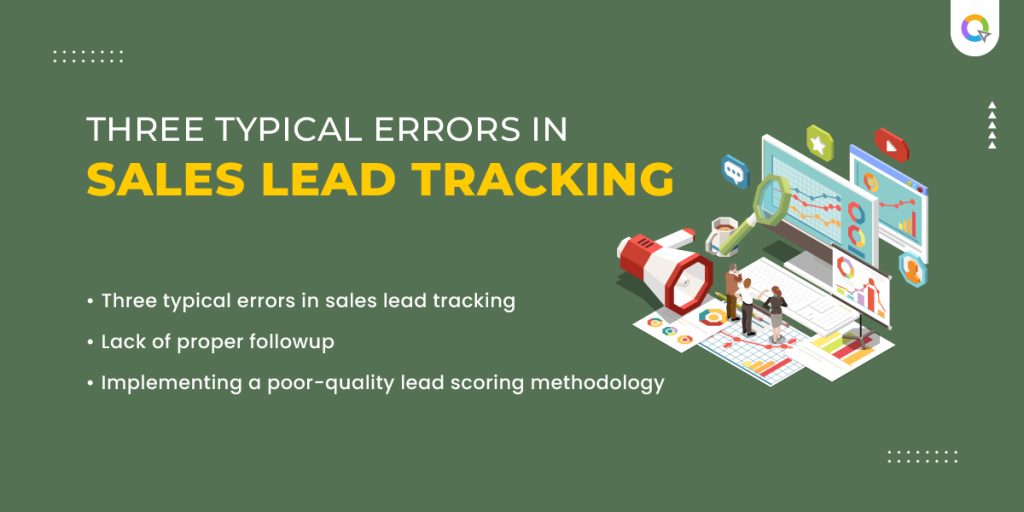
Many marketing and sales professionals find lead tracking to be a challenging procedure. The learning curve may be significant since numerous new responsibilities and resources must be mastered.
In all candor, you can’t guarantee perfection from your staff initially. There will be a lot of hiccups that prevent you from moving forward and converting more sales.
However, when keeping tabs on leads, it’s also important to avoid making certain common blunders. You may shorten your sales cycle without spending any more money by spreading awareness inside your organization about these types of blunders.
Lack of Attention to All Possible Leads
Your company’s marketing and sales staff may find new customers via any available lead sources. Email, phone calls, social media, natural search, personal recommendations, and online directories are among the most often used.
Obviously:
Different lead sources will provide you with different results. It may take more time and effort to get results from certain lead generating methods. Some are more generalized and may not be worth your effort in the long run unless you work in a certain industry.
How can you determine which methods of generating new business leads will provide the greatest results?
You need to monitor all of your potential lead sources so you can choose the top three to five channels to put more of your marketing efforts into. And you can only do that by trying out several different channels at once and keeping tabs on them all.
Lack of Proper Followup
Your sales process isn’t complete until you start tracking your leads. That’s the only reason this information is relevant: so that you can make better decisions. As a result, your lead-tracking efforts are as effective as a white crayon if you don’t put what you’ve learned into action.
Many businesses make the mistake of not following up with unqualified leads.
It’s easy to lose a lot of potential business if you don’t follow up on every lead you get. It’s best to prioritize closing deals with leads already primed to buy. Still, it’s just as crucial to keep prospective customers engaged in the awareness stage by providing them with consistent messaging and helpful material.
Once you’ve figured out what your prospect is into based on their actions, you can start interacting with them by sending them information designed to meet their requirements. Leads at the top of the funnel will become more engaged and eager to chat with you as a result.
Implementing a Poor-Quality Lead Scoring Methodology
Even if you have the best customer relationship management system and the most advanced monitoring capabilities, you may still have trouble keeping track of your leads. This is common when using a flawed lead scoring system to direct your work.
Here’s an example: If your internal teams are using the wrong metrics, they may misjudge the value of some leads or place them in the wrong stage of the sales cycle. As a result, you’ll lose precious time sending mixed signals to the wrong prospect.
When your firm uses a lead scoring system, it simplifies the job of everyone and ensures that your marketing and sales departments are always in sync. In this way, your SDRs may concentrate on the most promising prospects while passing the remainder off to the marketing department.
So, what exactly does the ideal method of tally-keeping for prospective clients entail?
When reviewing leads, your scoring model should prioritize these key indicators and information about your target audience. Regardless of where in the sales cycle your leads may be, you should be able to assign a score based on how well they meet your criteria.
Best Lead Management Software in the Market
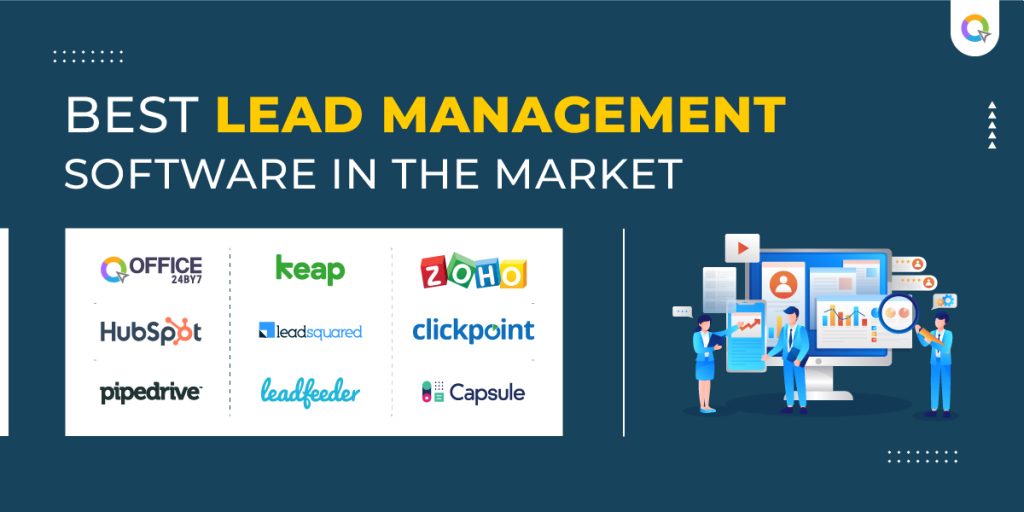
Here is a list of the best lead tracking software available in the market:
Office24by7
When managing leads, Office24by7 has you covered with its comprehensive and straightforward CRM lead tracking platform. You can see exactly how successful your efforts are converting into income thanks to the comprehensive perspective provided by the funnel tracking and the pre-built Pipeline Conversion Report.
It’s quick and easy to keep tabs on prospective buyers with the help of our handy tools. They’ll have quick access to powerful sales tools that are also among the best in the business and remarkably user-friendly.
With Office24by7, your sales team can focus on refining their outbound communications, including sales emails, cold email templates, and sales follow-up emails. For more information, review our supplemental materials about sales email samples and how to write efficient sales email subject lines.
Your users will always have rapid access to the greatest prospects thanks to your Lead Smart List, which they can search for in seconds. And Office24by7 automatically tracks calls and emails so that nothing gets lost in the mix while you’re out there making sales prospects.
Features:
- Customers Relationship Management for Big and Small Businesses
- Data mining and reporting on sales performance
- Management software for pipelines
- Use through a mobile device
- Means of Cooperation
- Collaboration with Outside Parties
- The Monitoring of Emails
- Systematization of Procedures
- Indices of performance
Keap
To that end, Keap was developed as a CRM lead manager with scalability in mind. With Keap, companies can access technologies that streamline and automate the sales process, increasing the speed with which leads are converted into paying customers.
The flexible price options provided by Keap allow you to grow as your business does. With this plan, you may start with 500 contacts for one user at the cheapest price. Keap’s professional coaching is included in all its price tiers for a flat rate. You also get limitless email storage and data transfer assistance.
Features:
- Measurement of results and analytics
- Segmentation
- Web forms/landing pages
- Automated marketing systems
- Management of the Sales Pipeline
Zoho
Zoho CRM claims to be a 360-degree customer lifecycle platform that may benefit organizations of all sizes. It has powerful lead-tracking capabilities like omnichannel communication and targeted email marketing software tool, and it’s compatible with over 500 other popular applications. As a bonus, it includes an AI-powered chatbot and a variety of other channels of contact that companies can use to get in touch with customers wherever they may be online.
Standard functionality like pipelines and customer dashboards, as well as 10 fields for scoring criteria, are included in Zoho’s cheapest subscription.
Features:
- Means of Cooperation
- Software that can scan cards
- In-Real-Time Conversation
- Utilization of Social Networking Sites
- Directed email marketing campaigns
- Incorporation of Google Ads
HubSpot
The SalesHub from HubSpot is a CRM sales lead management application that allows companies to concentrate all of their prospect data and activity in one place. To intervene at the optimal time, users may see their whole contact history and monitor each interaction with customers using the pipeline features. HubSpot’s CRM Starter Plan for two users is reasonably priced per month.
SalesHub is an effective platform for evaluating leads, organizing them into prioritized categories, and monitoring ongoing correspondence.
Features:
- In-Real-Time Conversation
- The art of meeting scheduling
- Notifications and follow-ups through email
- Tracking and reporting dashboard
- Monitoring Replies to Emails
- Accessible through a portable application
LeadSquared
LeadSquared is a customer relationship management and lead management system popular in many fields. It is a helpful tool for firms with many business-to-consumer sales since it consolidates all of the customer touchpoints into a single platform, making it easier for teams to move on to the next job while still having access to all of the relevant data. LeadSquared is mobile-friendly, with apps available for both Android and iOS.
Features:
- Organizational tool for scheduling and keeping track of deadlines
- Automated marketing systems
- Indices of performance
- Pipeline administration
- Utilization of Social Networking Sites
Case In-Chief
If you’re a person, a small company, or a large corporation, Lead Docket is the lead flow software you need. It has online forms for gathering contact information from new leads, and it allows for automatic follow-up emails to keep leads interested and informed at every stage of the sales process. In addition, it has marketing optimization built in, which lets users track the origin of their leads and evaluate the success of their campaigns.
Integrations with other corporate tools are available in Lead Docket. These apps include DocuSign, MailChimp, and CallRail. Requests for quotations will be fulfilled promptly.
Features:
- Management of a Campaign
- Web-based registration sheets
- Extrapolating Information
- Management of the Sales Pipeline
- Instruments for prospecting
ClickPoint
ClickPoint’s clientele comes from various sectors, including K-12, higher education, mortgage, B2B, travel, franchises, the insurance industry, and contact centers. ClickPoint is a sales automation tool that helps firms increase their reach to prospects and automatically prioritize the transactions that matter most.
It may be used by salespeople in the office, on the road, or in a contact center. In addition, insightful sales data reveals which lead sources bring in the greatest value and which are underperforming.
Features:
- Organizational tool for scheduling and keeping track of deadlines
- Registration of Telephone Calls
- Auto-dialer
- Automated marketing systems
- Operations management for field sales teams
Pipedrive
Pipedrive is a cloud-based customer relationship management solution that encourages salespeople to concentrate on processes rather than results. It has all the necessary tools for handling leads, including call recording, client tracking, and electronic forms, among others. It also leverages analytics to make selling a science so that teams can decide how to improve their methods based on evidence rather than speculation.
Features:
- Retention strategies
- Organizational tool for scheduling and keeping track of deadlines
- Means of Cooperation
- Web forms/landing pages
- Dashboard
Leadfeeder
With Leadfeeder, companies can see exactly who is interested in their product, allowing sales teams to focus their efforts where they will have the most impact. It gives you a better understanding of your customers’ habits so that you can predict their demands and gives you the means to get in touch with prospects promptly so you don’t lose them to a more agile competition.
Leadfeeder’s price plans are best for B2B companies with at least one sales representative and are on a per month, per feature basis. Qualification, segmentation, and nurturing are just some of the capabilities included in this lead-tracking software. The system may also keep track of user interactions and operate as a customer relationship management tool.
Features:
- Dashboard
- Goal-setting and monitoring
- CRM
- Reporting/analytics
- Stats collection on page visits
Capsule of Lead
Brokers, aggregators, and contact centers may all benefit from using Lead Capsule, a lead management software platform. Its primary function is to collect and resell customer data to other companies so their time may be better spent on generating sales rather than prospecting. It aids in attracting potential customers to your business’s offerings, collecting data through online forms, and monitoring lead sources to ascertain which channels provide the most fruitful leads.
Features:
- Identifying the Original Source
- Pipeline administration
- Instruments for prospecting
- Segmentation
Conclusion
Methods and technology for generating leads are constantly developing. To ensure organizations’ long-term success, marketing professionals need access to detailed data, the ability to pose pertinent questions, and cutting-edge marketing technology.
Increasing brand recognition, sales, and the number of qualified leads your firm receives is essential.
Brands can boost the quantity of leads entering the sales funnel, as well as the level of interest from prospects, with the help of an efficient lead tracking solution.
Lead tracking software can assist you in achieving your goal of generating more high-quality leads and gaining a comprehensive overview of your lead generation efforts.



